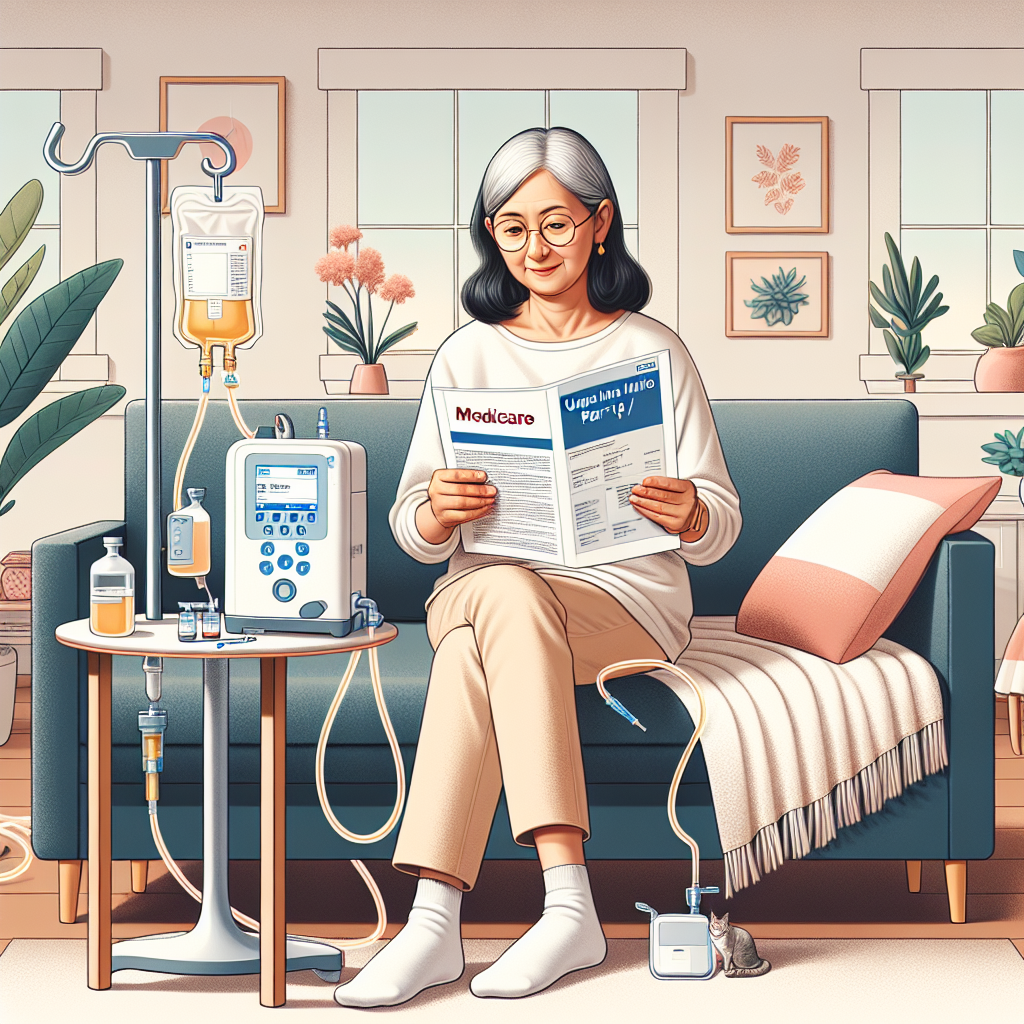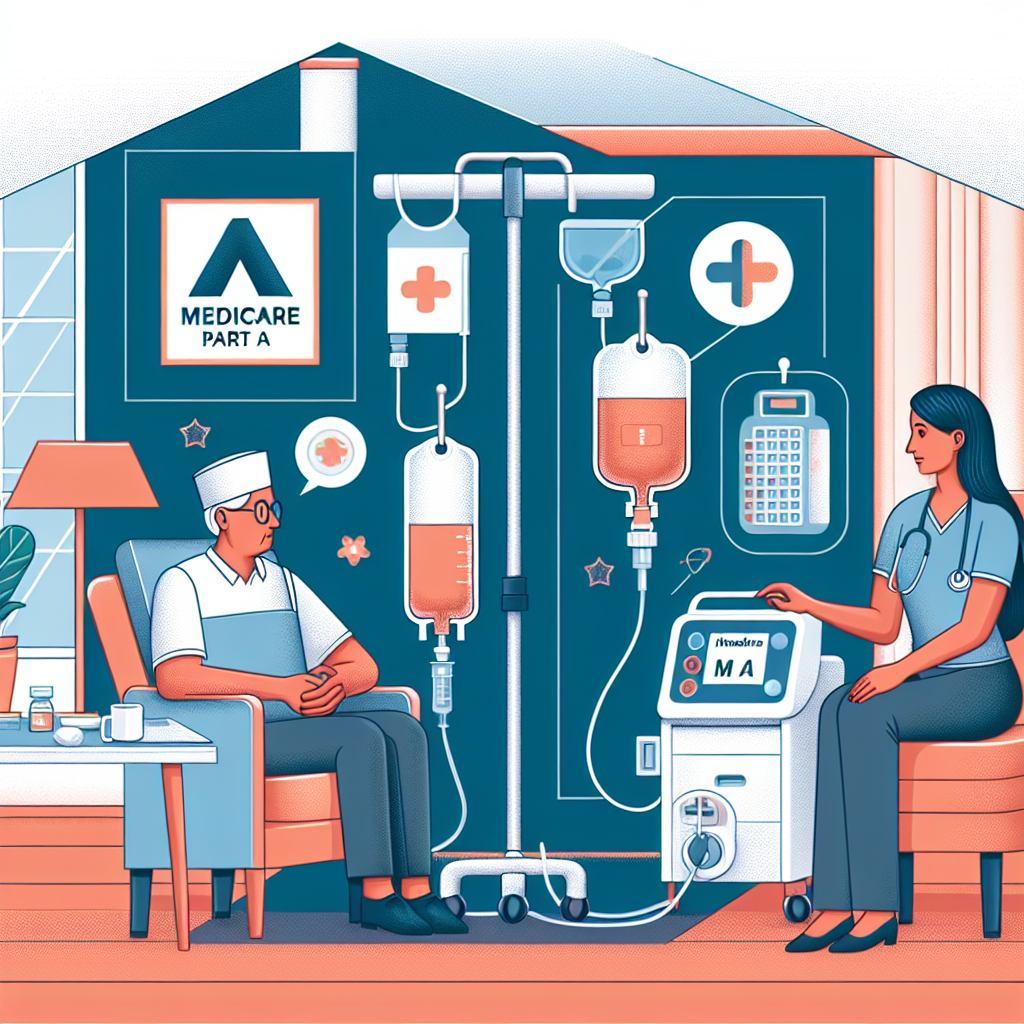Medicare Part A coverage for home infusion therapy is a crucial yet often overlooked aspect of healthcare. This service allows patients to receive necessary medications and treatment in the comfort of their own homes, providing convenience and independence. Through Medicare Part A, eligible individuals can access a range of infusion therapies for various medical conditions, including chronic illnesses and acute infections. Understanding the ins and outs of this coverage is essential for those in need of long-term or specialized medical care. Join us as we delve into the details of Medicare Part A coverage for home infusion therapy and explore the benefits it offers to patients.
Understanding Medicare Part A Coverage for Home Infusion Therapy
- Definition of home infusion therapy
Home infusion therapy refers to the administration of medication through an intravenous line or catheter at a patient’s residence. This form of treatment allows individuals to receive necessary medications without the need for hospitalization, promoting convenience and comfort for patients with chronic conditions requiring ongoing infusion therapy.
- Overview of Medicare Part A coverage
Medicare Part A covers a wide range of healthcare services provided on an inpatient basis, including home infusion therapy under certain circumstances. This coverage extends to eligible beneficiaries who meet specific criteria and require infusion therapy as part of their treatment plan. Understanding the extent of coverage is crucial for individuals seeking home infusion therapy to ensure they can access necessary medications and services without facing financial barriers.
- Eligibility criteria for Medicare Part A coverage for home infusion therapy
To qualify for Medicare Part A coverage for home infusion therapy, individuals must meet certain criteria, including being enrolled in Medicare Part A and meeting the requirements for homebound status. Additionally, patients must have a skilled need for infusion therapy, as determined by a healthcare provider, to be eligible for coverage under Medicare Part A. Understanding these eligibility criteria is essential for individuals seeking home infusion therapy to navigate the Medicare coverage process effectively and access the care they need.
Benefits of Home Infusion Therapy

Home infusion therapy offers several advantages for patients requiring ongoing treatment:
- Convenience and Comfort for Patients: Home infusion therapy allows patients to receive necessary medications and fluids in the comfort of their own homes. This eliminates the need for frequent hospital visits, reducing travel time and disruptions to daily life. Patients can adhere to their treatment schedules more easily, leading to better outcomes and improved quality of life.
- Cost-Effectiveness Compared to Hospital-Based Treatments: Home infusion therapy is often more cost-effective than receiving treatment in a hospital setting. By avoiding hospital stays and associated expenses, patients can benefit from significant cost savings over time. Additionally, home infusion therapy may reduce the need for emergency room visits and hospital readmissions, further lowering healthcare expenditures.
- Reduced Risk of Infections and Complications: Home infusion therapy can help minimize the risk of healthcare-associated infections and complications that may arise in a hospital environment. Patients receiving treatment at home are exposed to fewer pathogens, reducing their susceptibility to infections. This can lead to faster recovery times, fewer treatment interruptions, and overall improved health outcomes.

Types of Medications Covered Under Medicare Part A for Home Infusion Therapy
- Antibiotics: Medicare Part A covers a wide range of antibiotics for home infusion therapy. These medications are essential for treating various bacterial infections such as pneumonia, urinary tract infections, and skin infections. Examples of antibiotics covered under Medicare Part A include vancomycin, cefazolin, and meropenem.
- Pain management drugs: Medicare Part A also includes coverage for pain management drugs administered through home infusion therapy. These medications are crucial for managing chronic pain conditions, post-operative pain, and cancer-related pain. Examples of pain management drugs covered under Medicare Part A include morphine, hydromorphone, and fentanyl.
- Parenteral nutrition solutions: For patients who require nutrition support through intravenous means, Medicare Part A covers parenteral nutrition solutions. These solutions are specially formulated to provide essential nutrients to individuals who are unable to consume food orally. They are commonly used for patients with gastrointestinal disorders, severe malnutrition, or those undergoing certain medical treatments. Examples of parenteral nutrition solutions covered under Medicare Part A include total parenteral nutrition (TPN) and peripheral parenteral nutrition (PPN).
Antibiotics
- Importance of antibiotic therapy in home settings
Antibiotics play a crucial role in treating various infections and illnesses, making them a vital component of home infusion therapy. Administering antibiotics at home can improve patient comfort, reduce the risk of hospital-acquired infections, and enhance overall treatment adherence. This allows patients to receive necessary care in the familiar and comforting environment of their own homes, promoting better outcomes and quality of life. - Coverage limitations and restrictions
While Medicare Part A does cover certain antibiotics for home infusion therapy, there are limitations and restrictions to be aware of. Coverage may vary based on specific criteria such as the type of infection being treated, the prescribed medication, and the duration of treatment. It is essential for patients and healthcare providers to understand these limitations to ensure proper coverage and reimbursement for antibiotic therapy under Medicare Part A.
Pain Management Drugs
- Role of pain management in home infusion therapy: Pain management drugs play a crucial role in home infusion therapy as they help alleviate discomfort and improve the overall quality of life for patients receiving treatment at home. These medications are administered intravenously, ensuring rapid and effective relief from pain symptoms without the need for frequent hospital visits.
- Medicare guidelines for coverage of pain medications: Medicare Part A provides coverage for certain pain management drugs used in home infusion therapy, subject to specific guidelines. To be eligible for coverage, the prescribed pain medications must be deemed medically necessary for the patient’s condition and administered by a licensed healthcare provider. Additionally, the drugs must be included in the Medicare-approved list of covered medications for home infusion therapy. It is essential for patients and providers to adhere to Medicare’s guidelines to ensure reimbursement for pain management drugs utilized in home infusion therapy.
Parenteral Nutrition Solutions
Parenteral nutrition solutions encompass vital nutritional support for individuals who are unable to eat or properly digest food through the gastrointestinal tract. This specialized form of therapy is designed to deliver essential nutrients directly into the bloodstream, bypassing the digestive system altogether. Medicare Part A provides coverage for parenteral nutrition solutions for eligible beneficiaries who require this critical form of treatment to maintain adequate nourishment and overall health.
Coverage Details for Parenteral Nutrition under Medicare Part A
Under Medicare Part A, coverage for parenteral nutrition solutions is typically included as part of the home infusion therapy benefit. To qualify for coverage, patients must meet specific criteria outlined by Medicare, including a demonstrated medical necessity for parenteral nutrition due to an inability to consume or absorb nutrients orally. Additionally, the treating healthcare provider must prescribe the parenteral nutrition therapy as part of a comprehensive plan of care.
Medicare Part A generally covers the costs associated with the parenteral nutrition solution itself, including the necessary nutrients, fluids, and supplies required for administration. However, it’s essential for beneficiaries to verify coverage details with their healthcare provider and Medicare to ensure compliance with all eligibility requirements and documentation guidelines. Overall, Medicare Part A plays a crucial role in facilitating access to essential parenteral nutrition solutions for patients in need of home infusion therapy.
Process of Receiving Home Infusion Therapy Under Medicare Part A
Under Medicare Part A coverage, the process of receiving home infusion therapy involves several key steps to ensure patients receive the necessary care in the comfort of their own homes. Here is a breakdown of the intricate process:
- Referral Process from Healthcare Provider
- The first step in receiving home infusion therapy under Medicare Part A is the referral process initiated by the healthcare provider. This referral is essential to indicate the need for home infusion therapy and kickstart the evaluation process.
- Evaluation by Home Infusion Therapy Provider
- After the referral is made, a home infusion therapy provider conducts a comprehensive evaluation of the patient to assess their specific needs and determine the appropriateness of home infusion therapy as a treatment option. This evaluation is crucial in developing a personalized treatment plan tailored to the individual’s medical condition.
- Development of Personalized Treatment Plan
- Once the evaluation is complete, the home infusion therapy provider collaborates with the healthcare team to develop a personalized treatment plan that outlines the specific medications, dosages, and administration schedules required for the patient’s therapy. This plan takes into account the patient’s unique medical needs and ensures that they receive the appropriate care.
- Monitoring and Follow-Up Care

- Throughout the course of home infusion therapy, ongoing monitoring and follow-up care are integral components of the process. The healthcare team, in coordination with the home infusion therapy provider, regularly assesses the patient’s progress, monitors for any potential side effects or complications, and makes adjustments to the treatment plan as needed to optimize outcomes. This continuous monitoring and follow-up care help ensure the safety and efficacy of home infusion therapy under Medicare Part A coverage.
Challenges and Considerations for Patients Receiving Home Infusion Therapy
Receiving home infusion therapy can present various challenges and considerations for patients that require careful attention to ensure successful treatment outcomes. Some of the key challenges and considerations include:
- Adherence to treatment schedule:
Patients receiving home infusion therapy must adhere to a strict treatment schedule to ensure the effectiveness of the medications being administered. Missing doses or not following the prescribed schedule can impact the treatment’s efficacy and potentially compromise the patient’s health. It is essential for patients to establish a routine and set reminders to help them stay on track with their treatment plan. - Storage and handling of medications:
Proper storage and handling of medications used in home infusion therapy are crucial to maintain their stability and potency. Patients need to follow specific instructions provided by their healthcare providers regarding the storage conditions, such as temperature requirements and protection from light. Additionally, patients should be educated on the safe handling practices to prevent contamination and ensure the integrity of the medications. - Communication with healthcare team:
Effective communication with the healthcare team is essential for patients receiving home infusion therapy. Patients should feel comfortable reaching out to their healthcare providers with any questions, concerns, or changes in their condition. Clear and open communication can help address any issues promptly, adjust the treatment plan as needed, and ensure that patients receive the necessary support throughout their therapy. - Emergency preparedness and contingency planning:
Patients undergoing home infusion therapy should be prepared for potential emergencies that may arise during the treatment process. It is crucial to have a comprehensive emergency plan in place, including contact information for healthcare providers, instructions for responding to adverse reactions, and access to emergency services if needed. Patients should also have contingency plans for situations such as power outages or disruptions in the supply of medications to prevent any interruptions in their treatment.
FAQs: Medicare Part A Coverage for Home Infusion Therapy
What is home infusion therapy and how does it benefit Medicare Part A beneficiaries?
Home infusion therapy involves the administration of medications or fluids through a needle or catheter at home, rather than in a hospital or clinic setting. This type of treatment is beneficial for Medicare Part A beneficiaries who may require ongoing infusion therapy for conditions such as infections, immune disorders, or chronic illnesses. By receiving treatment at home, beneficiaries can avoid the inconvenience and cost of frequent visits to a healthcare facility.
Does Medicare Part A cover home infusion therapy?
Yes, Medicare Part A coverage includes home infusion therapy services for eligible beneficiaries. This coverage typically includes the cost of the drugs, supplies, equipment, and nursing services needed for the infusion therapy. However, certain criteria must be met in order for Medicare Part A to cover home infusion therapy, such as the therapy being considered medically necessary and the beneficiary meeting specific eligibility requirements.
How can Medicare Part A beneficiaries access home infusion therapy services?
Medicare Part A beneficiaries who require home infusion therapy services can typically access these services through a home healthcare agency that is approved by Medicare. The agency will work with the beneficiary’s healthcare provider to coordinate the delivery of the necessary medications, supplies, and equipment for the infusion therapy. The agency will also provide skilled nursing services to administer the therapy and monitor the beneficiary’s progress.
Are there any out-of-pocket costs associated with Medicare Part A coverage for home infusion therapy?
Medicare Part A beneficiaries may be responsible for certain out-of-pocket costs associated with home infusion therapy, such as copayments, coinsurance, or deductibles. The amount of these costs will depend on factors such as the specific services received, the beneficiary’s Medicare coverage, and whether the beneficiary has supplemental insurance. It is important for beneficiaries to review their Medicare coverage and speak with their healthcare provider to understand their potential out-of-pocket costs for home infusion therapy.